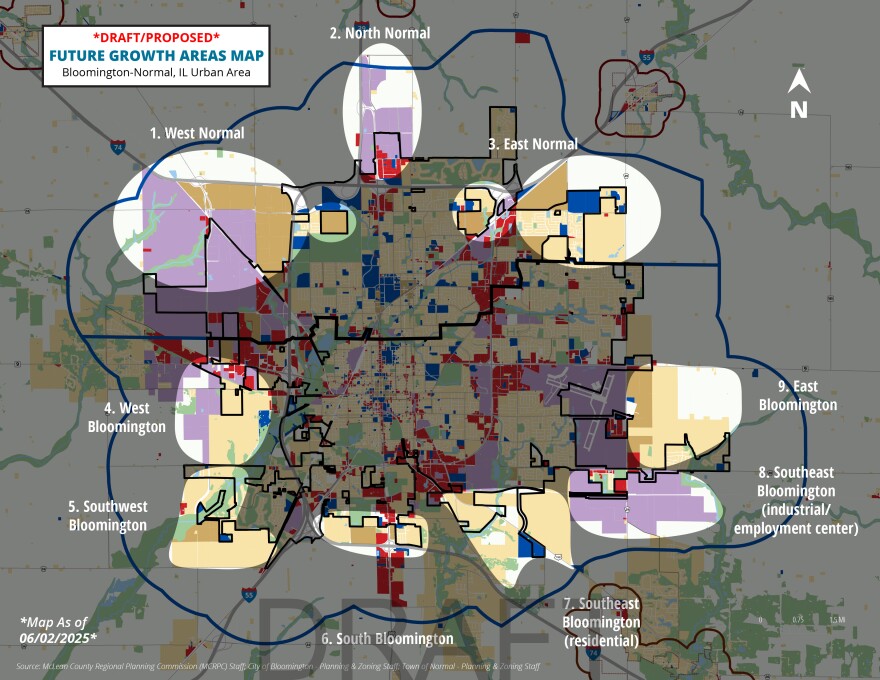A draft McLean County Land Use Plan is getting pushback from various stakeholders.
The McLean County Regional Planning Commission developed the preliminary land use plan after involving staff from the county, City of Bloomington, and Town of Normal. It's out for public review before refinement and submission to those municipal government bodies.
Early reviews are mixed — on content and process. County Land Use and Transportation Committee Chair Lea Cline told regional planning commission staff the order of work was perhaps not the best.
"Generally speaking, the process in the county is that a lot of this work happens on the front end with community feedback, engagement with the different partners, and so the first draft of a plan is usually pretty far along, right? I would consider it almost one step away from publication. But the presentation of the plan that was given to us was so far behind that that it's very confusing to people," said Cline.
The consequence of that process came out in public comments at Tuesday's county Land Use committee meeting.
Tricia Braid said she was surprised at what she found when she looked into the plan.
"I became aware of the plan when I saw a WGLT Facebook post. Farmland my family owns in Funks Grove had been marked for future residential development. My first thoughts were — how are these areas or any others for that matter determined to be the location for future residential development? Same question for future industrial development areas. And also, no thank you very much," said Braid.
Braid was not alone in her surprise. Illinois State University professor and first-generation farmer Ruth Burke said setting the basis for the draft without also taking community wishes into account creates assumptions that are hard to change later in the process.
"Acceptance of this plan depends on the ignorance of the stakeholders. The voices behind this plan aren't bringing stakeholders along in their knowledge curve. It's anchoring them to the bottom of it," said Burke.

And Braid said a plan generated largely by municipal staff also cuts out another important part of representative government.
"When will elected officials consult the public for input in this plan? Moving it straight from the commission to the full board to vote to adopt is unacceptable,” said Braid.
Rural mayors haven't been part of the dialogue yet either.
Regional Planning Commission staff now say they'll change the process. Community Planner Anthony Baumann said you can now view the public comment period ending late this month as just the first round of outreach. Baumann said they will add another round or two of input.
"We're going to talk to stakeholders. We're going to talk to township supervisors, road commissioners, elected officials and then host a few public comment forums, in-person public meetings, and then we'll most likely set up a second round of outreach with an updated draft plan," said Baumann.
Sprawling development vs. infill
The feedback is not likely to be uniformly positive. The draft plan identifies growth areas in the county that are at the edges of Bloomington-Normal.
"A lot of what is in this plan, I would say is counter to what we want in this community," said Noah Tang, a history teacher and the head of the Bloomington-Normal chapter of the urban design reform and advocacy group Strong Towns. Tang said analysis shows per acre economic impact to the community is highest in downtown Bloomington and Uptown Normal not in single-use residential subdivisions.
"If you continue to build sprawling developments that don't pay for themselves, you start to see the continuing deterioration of our quality of our infrastructure," said Tang.
Tang said tax revenue from new development often does not pay for upkeep of roads, water, and sewer, particularly in low-density developed areas like the suburban east side. He said in 1970 Bloomington had about 200 street miles. In 2010 it was more than 400 street miles.
"We have a lot more roads to take care of than before and a lot less dense community to do so. There is much more road to take care of for a lot fewer residents, and I think continuing this pattern of suburban sprawl is a very, very bad idea," said Tang.
The plan also suggests creation of an east side transportation corridor east of Towanda Barnes Road to help future development connect contiguously. Tang is not a fan.
"Read the room! The east side corridor has been killed over and over again. It is not needed. And especially after the downsizing at State Farm corporate headquarters, the traffic counts don't necessarily warrant this," said Tang.
Tang said a lot of the plan is counter to goals of making Bloomington-Normal a more walkable and compact community. Others, like Ruth Burke, said they fear loss of farmland.
"Another neighbor's family has been on their land for over 100 years. That land is now future-zoned as M-2 [manufacturing] use. This family was not aware of this. Even their home site is replaced by M-2 use," said Burke.
Burke and Tricia Braid said they do not want more of rural McLean County and its heritage swallowed by the urban area. Braid said the county should hold the line to prevent "governance creep" by the city and town.
“I'm not against growth. I'm against our resources being depleted so that elected officials in town can press the easy button," said Braid.
After the regional planning commission takes in all the new public and stakeholder input, the land use plan is supposed to guide development of new county, town, and city comprehensive plans. For instance, the last county comprehensive plan came out in 2009, and staff said it is overdue for a refresh.
Regional Planning Commission Community Planner Anthony Baumann said in a recent WGLT interview that it's in those comprehensive documents that a lot of the details the stakeholders worry about will really be decided.


